2500+
Successful Projects
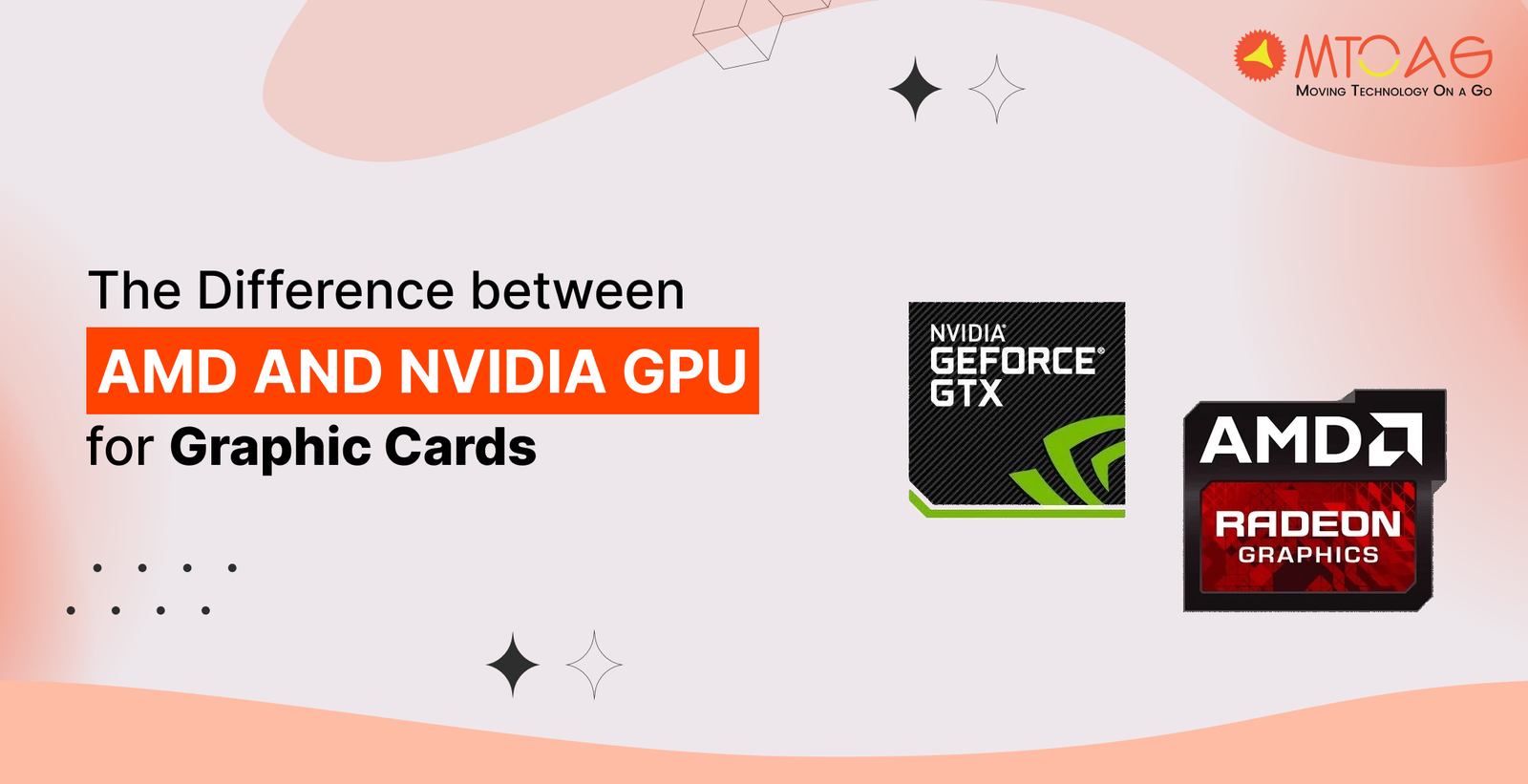
Nvidia and AMD make the greatest graphics cards available, but it might be difficult to decide between them. In contrast to previous generations, AMD and Nvidia GPU square off against one another in 2024, making brand selection more complicated than just tallying your cash.
Every graphics card from AMD and Nvidia GPU in this generation has been meticulously evaluated, not just for raw performance, but also for features like ray tracing performance, FSR, and DLSS, as well as how VRAM functions in contemporary titles. These are the results of a comprehensive comparison of AMD vs. Nvidia graphics cards in 2024.
Table of Contents
Before we dive into the specifics, let's take a moment to look at the exciting scenario for AMD and Nvidia in 2024. Both giants are gearing up to release their next generation of graphics cards, and we can't wait to see what they have in store. The anticipation for these new releases is palpable, and we're here to keep you updated.
The Ada Lovelace GPUs from Nvidia are also known as the RTX 40-series graphics cards. Although only eight of the cards are officially part of Nvidia's range, there are ten in total. The following list should dispel any confusion.
The RTX 4070 Ti and RTX 4080 are the two missing GPUs; a Super Refresh has replaced them. The only other GPU with a Super Refresh, the RTX 4070 Ti, is still available despite its official discontinuation.
The RTX 4060 Ti is the only peculiar product in Nvidia's range, except the Super Shifting. This GPU is available in the 8GB model and the 16GB version. The memory capacity varies, but other than that, they are precisely the same graphics card.
AMD doesn't have to worry about super updates, as it only has seven GPUs in its range. Here's a quick glimpse at AMD's RDNA 3 range:
We arranged the graphics cards in both scenarios in order of power; for instance, the RTX 4070 Ti has greater power than the RTX 4070. Comparing the lineups of Nvidia and AMD may help you gain your bearings, although the details could be more precise.
The table below illustrates the general comparison between AMD and Nvidua's possibilities. Performance and cost will be discussed later, but for now, they represent the general counterparts from both brands.
Nvidia | AMD |
RTX 4090 | — |
RTX 4080 Super/RTX 4080 | RX 7900 XTX |
RTX 4070 Ti Super | RX 7900 XT |
RTX 4070 Ti | — |
RTX 4070 Super | RX 7900 GRE |
RTX 4070 | RX 7800 XT |
— | RX 7700 XT |
RTX 4060 Ti 16GB/8GB | — |
— | RX 7600 XT |
RTX 4060 | RX 7600 |
If you're set on a particular brand of GPU, you will only sometimes have an option if there are a few strange holes in the selection. Once again, the gaps show how we ranked the cards in this order based on total power. The RX 4060 Ti, for example, has more power than the RX 7600 XT, and the RX 7700 XT has more power than that.
Comparing the costs of the latest GPUs from AMD and Nvidia GPU makes little sense. With generational price shifts, specific GPUs are now more directly competing with one another. Here is a breakdown of the price of a current-generation GPU as of the publication date:
There are many overarching patterns. AMD GPUs are often less expensive when you compare this list of pricing to the GPU stack above. In addition to being the least costly GPU in the current generation range, the RX 7600 is also somewhat less expensive than the RTX 4070, the direct competitor. This is especially true with cards like the RX 7800 XT.
Virtually every one of these GPUs is easily found at internet stores, either at list price or less. The exception is the RTX 4090. It flew off the shelves because of the AI craze, and even now, it's difficult to locate one or less than $2,000. The RTX 4090 is not a good purchase right now and may never be.
AMD has a distinct price advantage with or without the RTX 4090 controversy. The Nvidia portfolio is highly segmented, especially in the $400 -$600 range. AMD offers a significantly more condensed portfolio with distinct performance levels between each model at this price point. With the help of the Super Update, Nvidia GPUs at the top end of the market are still listed at list pricing, while AMD's alternatives have gradually become less expensive.
Winner: AMD
We have included links above to reviews of every current-generation GPU from Nvidia and AMD. If a certain card piques your interest, be sure to read our evaluations for a thorough analysis of benchmarks. Here, considering our whole test suite, we will discuss some broad points of comparison for the three main resolutions.
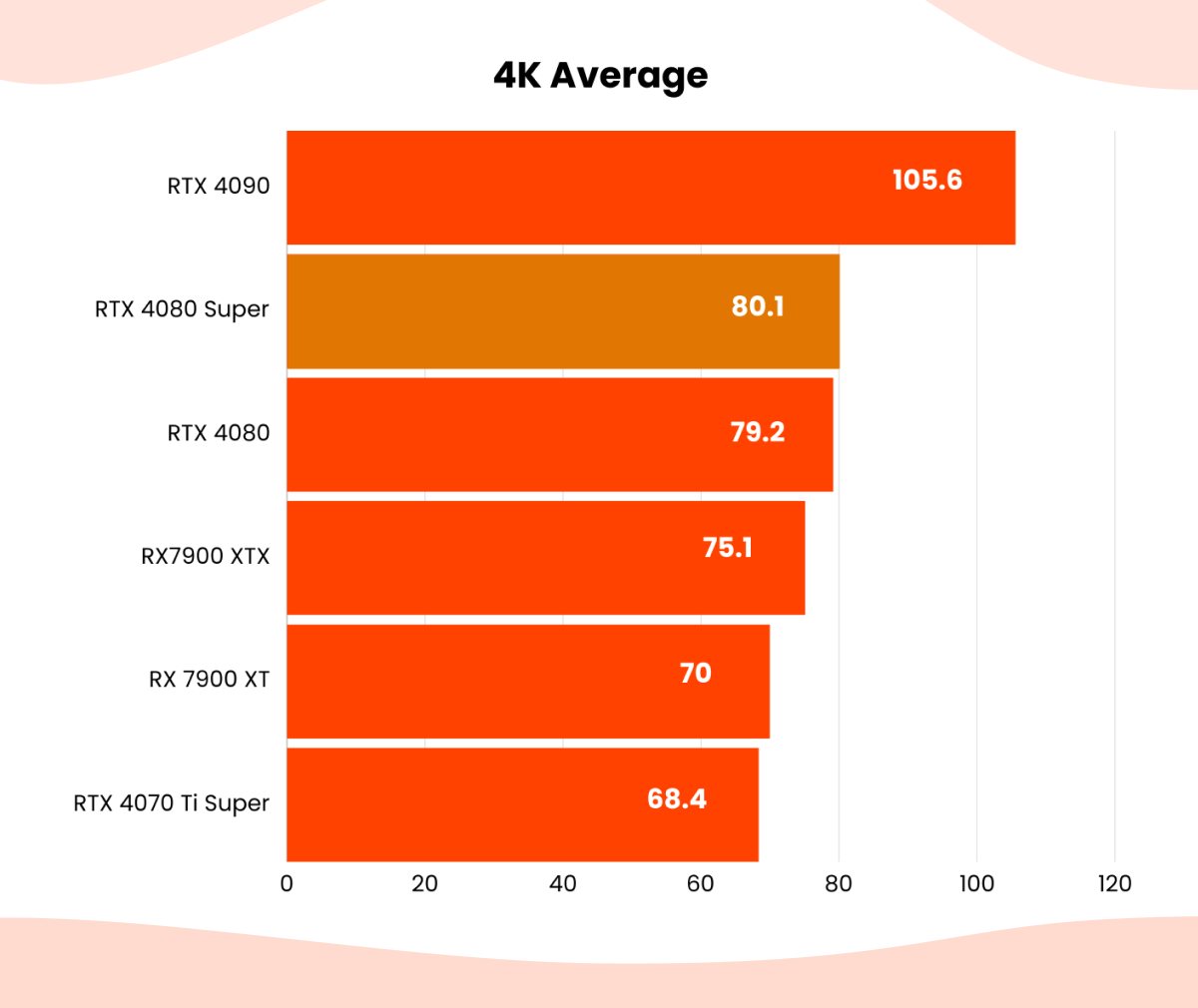
Nvidia undoubtedly prevails at the upper end of performance, starting with 4K. The RTX 4090 is just too strong a GPU to compete with, giving Nvidia a significant advantage. Down the stack, AMD's direct rival is defeated by the RTX 4080 Super, but AMD prevails below $1,000. The RX 7900 XT, which is $1,000 less expensive than the RTX 4070 Ti Super, is an excellent example.

At 1440p, that narrative picks up, mostly on the rear of the RX 7900 GRE. It is $50 less expensive than the RTX 4070 Super and performs much better than the RTX 4070 at the same price. Similarly, even though it costs around $50 less, the RX 7800 XT beats the RTX 4070 by a small margin.
These tests test our whole suite, which also includes a few ray-tracing games. The following section will examine ray tracing in more detail since Nvidia often leads in this area. With the exception of ray tracing, AMD's direct rival frequently performs better at the exact cost.
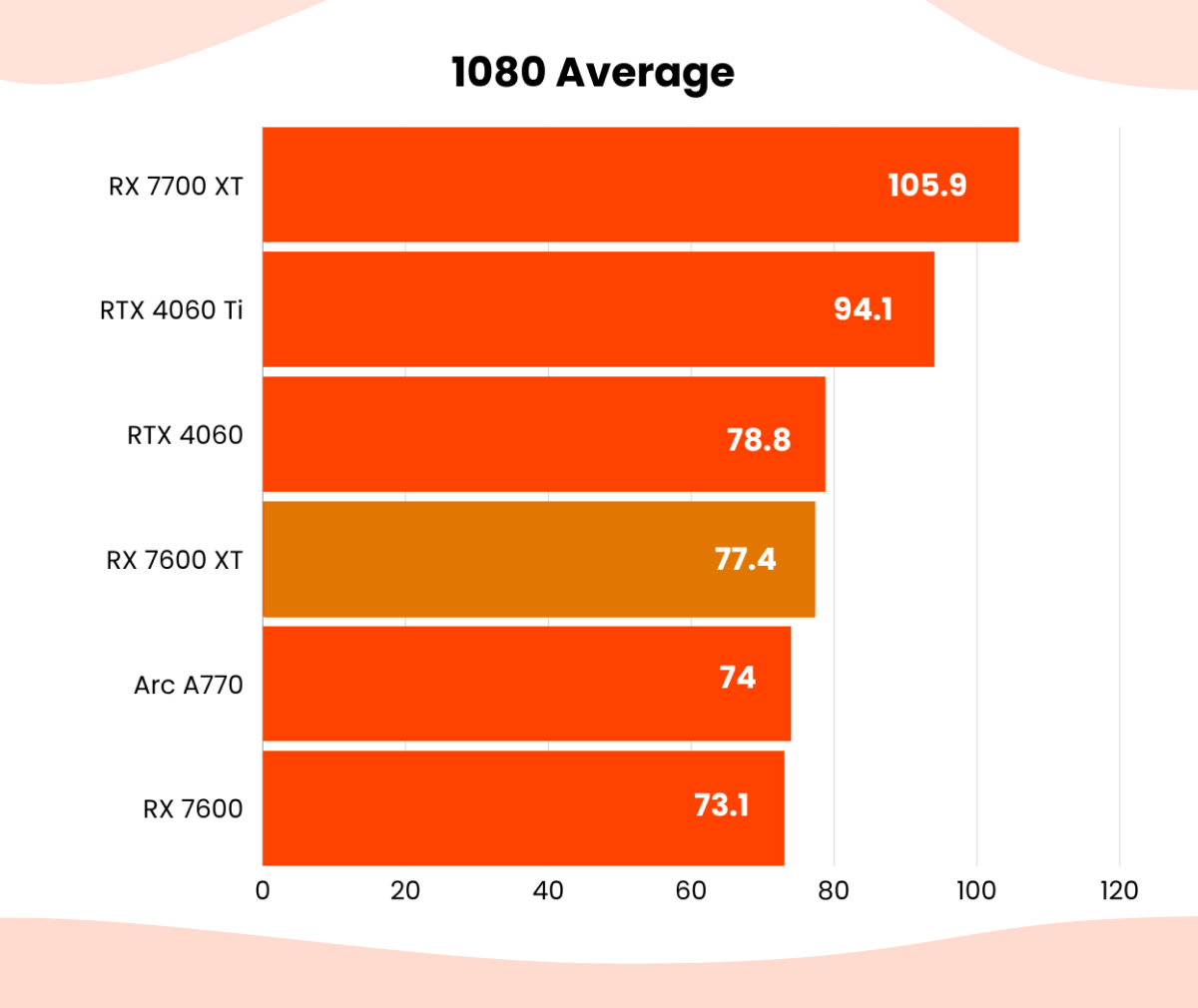
At 1080p, things seem different, which is unexpected considering how poorly Nvidia's cards, like the RTX 4060, have been received. Compared to the RTX 4060 Ti, the RX 7700 XT is an excellent choice; however, the RX 7600, and particularly the RX 7600 XT, fall short. For 1080 gamers, Nvidia now provides a better balance with the RTX 4060 and RTX 4060 Ti.
When it comes to overall performance, AMD excels in the sweet spot between higher-end 1080p gaming and lower-end 4K gaming, offering more performance for your money. In general, Nvidia offers superior peak performance and a more affordable option at the bottom of the stack. But there are many factors besides performance to take into account.
In the following two sections, we'll discuss feature support and ray tracing, where Nvidia again has the upper hand. AMD prevails in this category because of its superior overall performance.
Winner: AMD
Since the release of RTX GPUs in 2018, Nvidia has dominated the ray tracing market, but AMD is now much closer than it was. The fact that most games these days, like Resident Evil 4, have less demanding ray tracing solutions is largely to blame for AMD's GPUs performing far better than they did a few years ago.
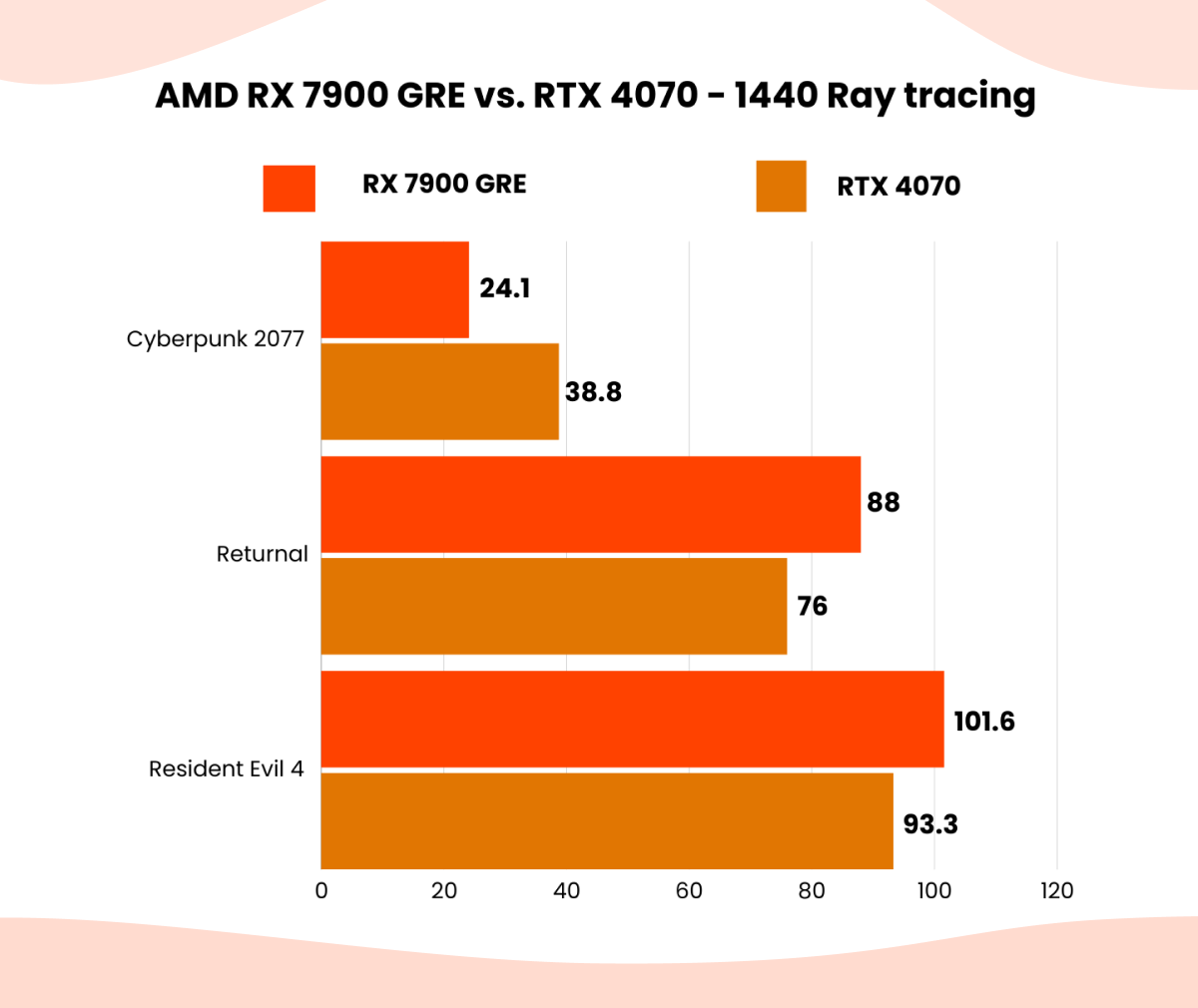
Above is an example of it in action. Even though both GPUs are priced similarly, the RX 7900 GRE outperforms the RTX 4070 in less demanding titles like Resident Evil 4 and Returnal when ray tracing is enabled.
There's much more to this tale, and Cyberpunk 2077 offers a clue as to why. Nvidia is ahead in the most demanding ray tracing games. Based on an average that takes into account these ray tracing findings, as you can see in the previous section, the RX 7900 GRE outperforms the advantage.
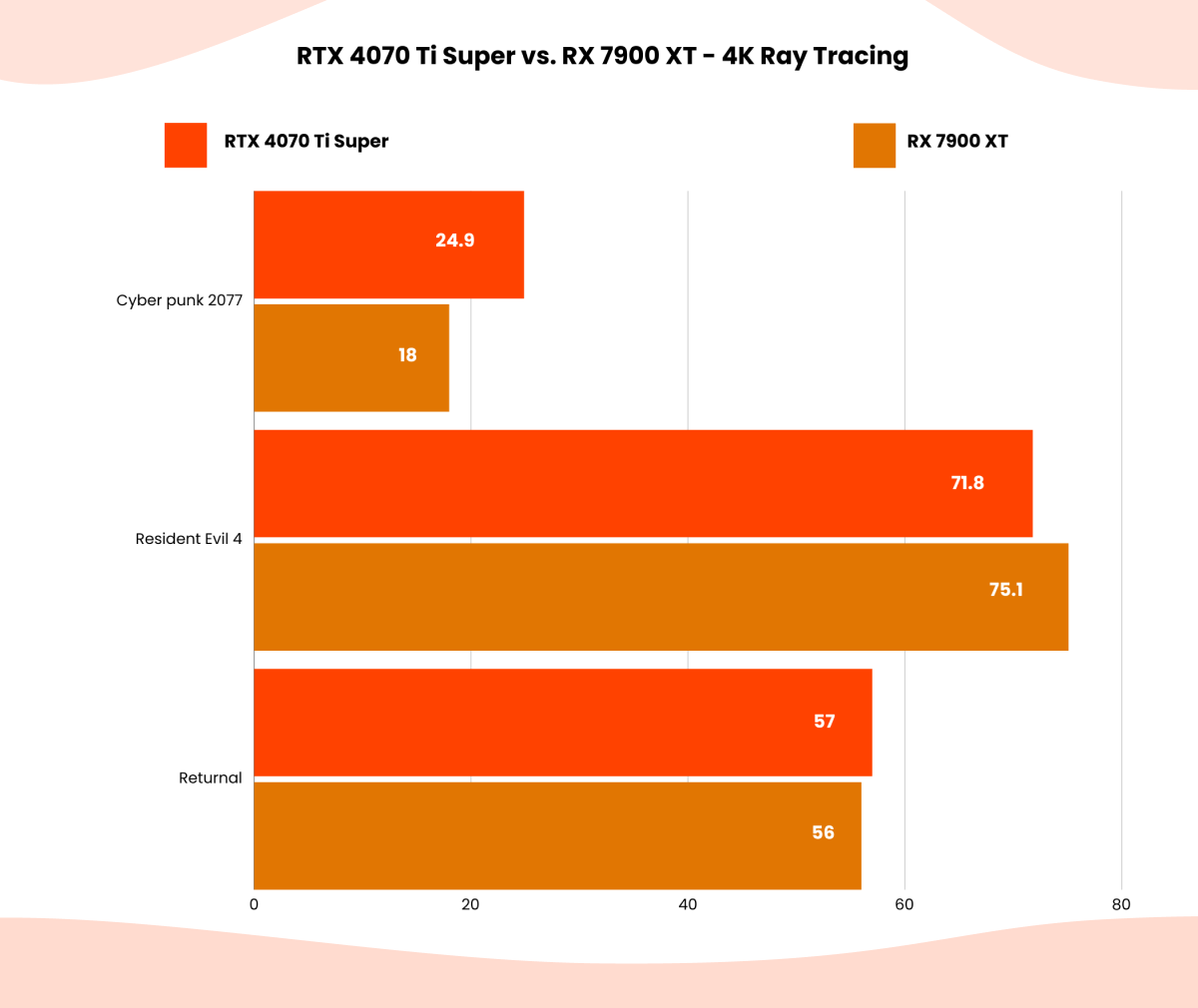
When you compare the RTX 4070 Ti Super and RX 7900 XT, you can see that Nvidia is still leading the way in ray tracing. While the GPUs exchange blows with the more accessible games, Nvidia has a significant advantage in Cyberpunk 2077.
While AMD can compete in specific ray-tracing games, Nvidia still prevails in this category. In most cases, a significant performance penalty is associated with wanting to observe your ray tracing. Because of the intricate, demanding lighting technology, games like Cyberpunk 2077, Alan Wake 2, and Portal with RTX look fantastic, and Nvidia can manage the heat of such challenging circumstances significantly better.
Winner: Nvidia
There is a strong tendency toward attributes indicating a GPU's level of performance. Over the last several years, AMD and Nvidia have made significant investments in software and technology. It's called Deep Learning Super Sampling (DLSS) for Nvidia and FidelityFX Super Resolution (FSR) for AMD. And they vary significantly from one another.
First, FSR jeopardizes two components, AMD first. Upscaling is the first step; it can be done on any GPU. It increases speed by displaying your game at a smaller resolution. Additionally, FSR 3, which incorporates frame development, is supposed to have a limited number of titles. This company uses two frames to increase your frame rate and creates one in between.
The main benefit of FSR is that it is compatible with GPUs from Nvidia, AMD, and Intel; it is not brand-specific. One disadvantage is that its appearance could be better. That's shown above in Horizon Forbidden West. FSR is much softer than DLSS, especially regarding Aloy's hair and the surrounding greenery.
FSR 3 frame generation is another disadvantage, for the time being as least. Although it seems fantastic, only a few games support this feature. There has yet to be a frame generation update for games like Cyberpunk 2077, Warhammer 40K: Darktide, and Ratchet and Clank Rift Apart for FSR 3.
You have DLSS on Nvidia's end. Its three main parts are Frame Generation, which creates an intermediate frame by comparing two—Super Resolution, which involves upscaling, and Ray Reconstruction, which enhances the quality of ray-traced effects. The primary distinction between DLSS and FSR is that the latter relies entirely on artificial intelligence (AI) and needs an RTX GPU to execute the AI model on specialized accelerators.
Hogwarts Legacy demonstrates the impact of AI. Compared to FSR, DLSS is able to retain a lot more information on the Shingles. Furthermore, DLSS is much more stable. Ghosting and flickering artifacts may occur in both FSR and DLSS. However, DLSS often handles finer details better than FSR.
While Frame Generation is limited to new RTX 40-series GPUs, DLSS Super Resolution and Ray Reconstruction are compatible with existing RTX GPUs. Although the two aspects are similar, DLSS 3 seems somewhat better than FSR 3. The fact that DLSS 3 is included in so many games—including Alan Wake 2, Cyberpunk 2077, and Remnant 2—is a major plus for Nvidia.
Since the release of DLSS, Nvidia has consistently outperformed AMD in terms of features, and this is still the case today. With their demanding path-tracing modes, games like Alan Wake 2 and Cyberpunk 2077 are made feasible in large part by DLSS, which is one of the primary reasons to purchase an Nvidia GPU.
Winner: Nvidia wins
There needs to be more of a contrast between Nvidia and AMD regarding driver support. When it comes to driver releases, we've had problems with both in the past, and both respond quickly to fix the issues. Alongside the introduction of new games, AMD and Nvidia also routinely update drivers. Find a winner by focusing on a specific game or driver release. Overall, the quality and support of drivers is comparable across AMD and Nvidia.
Software is a distinct issue. Before the release of the Nvidia App, AMD was a clear winner over Nvidia. You now have a single Nvidia app that includes additional programs like Nvidia Broadcast and ICAT, drivers, suggested settings, and gameplay recording.
Along with the essential functions, you also get an immediate replay, Nvidia Shadowplay recording, and a snapshot capability. However, Nvidia offers certain exclusive features that are exclusive to Freestyle. RTX Dynamic Vibrance and RTX HDR both use AI to improve the visuals of your games and are available to you if you have an RTX GPU.
In contrast to the previous iteration of the Nvidia App, known as GeForce Experience, none of these features require registration for an Nvidia account. That, in and of itself, significantly tips the software balance between Nvidia and AMD.
AMD offers Radeon Software, which has an equally extensive feature set. There are almost too many to mention. For compatible games, you may access graphical settings, performance monitoring, screenshots, video captures, and quick replays, as with GeForce Experience. With Radeon Software, you can overclock your GPU and stream as well.
However, Radeon Software offers some more perks. Integer scaling allows retro games to look better on contemporary screens, while AMD Link lets you and your friends connect to your PC remotely from almost any device. Radeon Software also provides access to all of AMD's gaming features, including FreeSync, Radeon Chill, and Radeon Anti-Lag.
While AMD had a significant advantage with Radeon Software in the past, Team Green is now on level thanks to the new Nvidia applications. These days, it's difficult to go wrong with either.
Winner: Draw
AMD and Nvidia offer mobile GPUs in addition to desktop graphics cards. However, the number of laptops using Nvidia graphics cards is far higher. Like AMD vs. Intel, Nvidia has a much more significant market share in mobile, and laptops with an Intel CPU and Nvidia graphics card are more common.
Making any definitive judgments on the relative performance of AMD and Nvidia mobile GPUs is difficult. For instance, in the Asus ROG Strix G15, the RX 6800M performs better than the RTX 3080 found in the MSI GS66 Stealth. Nevertheless, the MSI laptop lacks a fully functional RTX 3080 and a more capable coding system. So, in terms of mobile graphics cards, is AMD better? It involves more work than just performing raw.
Laptop designers are free to choose how much power the GPUs get, and mobile graphics cards are not comparable to their desktop equivalents. For instance, the MSI GS66 Stealth's RTX 3080 has a 95W maximum power consumption. Naturally, the Razer Blade 15's RTX 3080 performs better and can use up to 105W of electricity. It becomes more difficult to compare if you include various cooling systems.
In the case of mobile GPUs, specific laptop evaluations are essential. There is no denying that different graphics cards work differently. For example, the RX 6800M will function better than the RX 6700M. However, the laptop design has a much more significant impact on performance when comparing two similar graphics cards than if you choose an AMD or Nvidia GPU.
But remember DLSS and ray tracing. These functions are still available for Nvidia mobile GPUs, and our findings about the desktop cards hold, too.
Winner: Nvidia
For years, AMD has made an effort to match Nvidia's performance. RX 7000 graphics cards not only meet but sometimes occasionally surpass that threshold. That highlights the cost and attributes. AMD graphics cards are more reasonably priced than those made by Nvidia. However, when you take into account DLSS and ray tracing, that additional cost makes sense.
That does not imply that AMD is a poor choice. AMD is a more robust choice in 2024 than it has been in a long time. This is especially true if you don't care about additional features and are just trying to obtain the best value for your money. However, this year's games depend on those capabilities, so Nvidia is our winner.